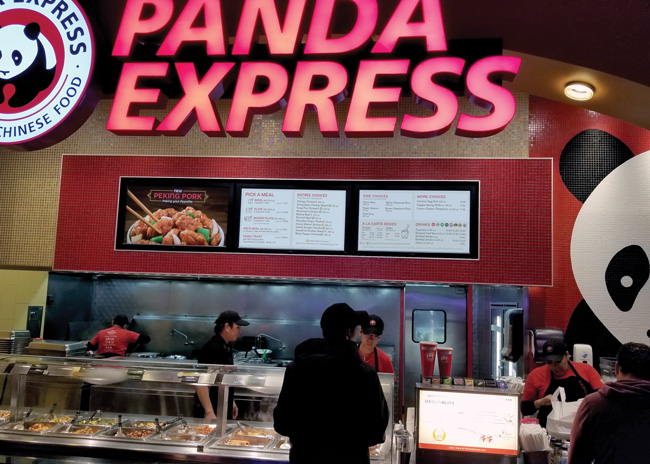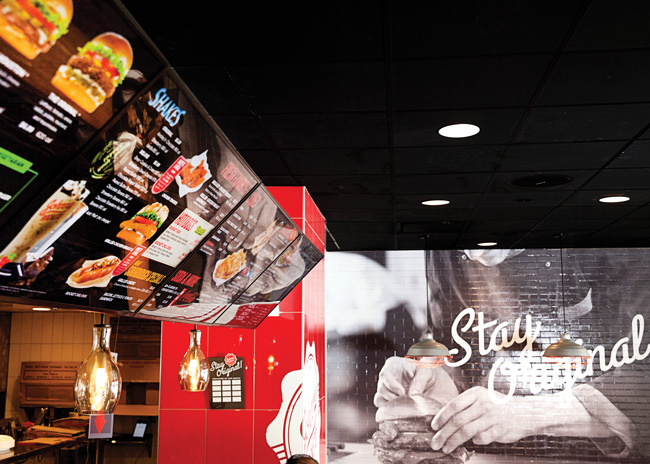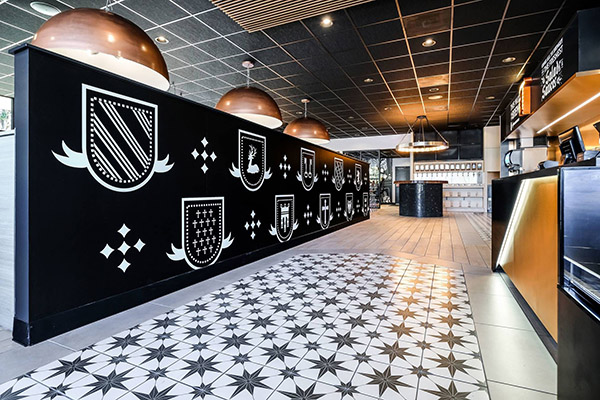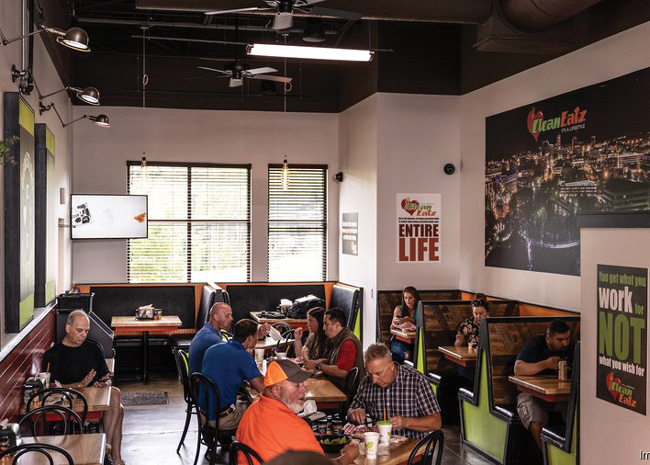For many customers, sights and sounds are important parts of a restaurant visit. Whether it’s background music, a lively pop soundtrack, TVs showing a big sporting event or a DJ laying down beats, audiovisual elements help define an establishment and can be integral to the customer experience.
A/V equipment also plays a practical role. In the quick-service market, for instance, video screens have become the preferred medium for menu displays. They provide vital information and help shape the experience by showcasing brand colors and graphics. In some cases, video displays provide patrons with something to read while they wait in an order queue or have a drink at the bar.
Despite these capabilities and benefits, A/V systems are often an afterthought when developing the overall design. And that’s too bad, because to get the most out of this equipment, it’s better to integrate the formulation of an A/V plan early in the design process.
Devising an audio plan begins with the owner’s vision for the establishment. An elegant fine-dining spot has a much different ambience than a quick-service restaurant, for instance. The type of music featured in each venue will vary accordingly. The former may opt for light background jazz, while the latter is more likely to choose a lively, upbeat playlist.
The style of music influences the number and placement of speakers, says Gregg Dixon, owner, AV Specialists, Inc. With light background music, fewer speakers are needed because the acoustic properties of this type of music travel better. On the other hand, upbeat music with heavy bass wouldn’t sound as good with the same number of speakers because you’d have to turn the volume up to pump the music further, Dixon explains. If there are too few speakers, the result would be a jarringly loud sound directly under each speaker with gaps of muted sound between speakers.
“The more speakers, the more similar the sound environment will be throughout the space,” Dixon says. A/V specialists determine the optimal speaker array based on a formula that considers the height of the speakers and their acoustic attributes — such as ability to project the bass end of the sound spectrum — as well as the cubic-foot measurement of the space. Note that the key dimension is cubic feet, not square feet. Spaces with high ceilings demand a more powerful sound system.
 Panda Express uses its digital menu boards to convey information about Asian cultural heritage along with meal offerings. Image courtesy of PTG
Panda Express uses its digital menu boards to convey information about Asian cultural heritage along with meal offerings. Image courtesy of PTG
Based on this analysis, A/V specialists typically present a range of sound system designs from an ideal high-end arrangement to the most economical arrangement on “the edge of what we recommend,” Dixon says. Owners can choose the best system for their budget.
The acoustic presence of a space — how a room reflects and/or absorbs sound — is another key factor when designing an audio system. A space primarily composed of hard surface materials such as brick walls, polished concrete floors and metal tables reverberates sound. This is a challenging acoustic environment as all sounds including kitchen activity and conversations among patrons mix together easily and can become cacophonous.
Rooms that have ample sound-absorbing materials are at the opposite end of the acoustic scale. “Overstuffed chairs, rugs and coffered ceilings are great for acoustics,” says Matthew Emmi, founder of technology design firm OneButton. “You have much different sound systems for the two ends of the spectrum.” When faced with a lively room, designers can add sound absorbing materials such as fabric, sound panels or sound-absorbing “clouds” that hang from the ceiling, Emmi says. Owners don’t always want to spend the money to add these utilitarian details, he adds. If good sound is important to your vision, however, then it is worth the extra expense, he says. Consider that a 2016 Consumer Reports survey noted that excessive noise is a top reason people complain in restaurants.
If the space has a highly reflective acoustic profile, more speakers help make music sound better. Figure on adding 20% to 30% more speakers for the most sound-reflective spaces, Emmi says.
The placement of speakers relative to patrons is also an important consideration. “Ear level is ideal, but I don’t think we have ever done that,” Emmi says, because finding places to affix speakers at that height is usually impractical if not impossible. A/V designers also consider the visual impact of speakers, typically aiming to hide them. Speakers are usually attached overhead — most commonly concealed behind a ceiling panel or fabric.
“We like to avoid putting speakers on a wall, because it looks like a design afterthought,” Emmi says. Occasionally, though, a design incorporates speakers as a visual element. Emmi worked on a high-end sushi restaurant with an open dining area and high ceiling. “We used vintage, boxy looking speakers hung from chains,” he says. “This looks like a high-end listening room in Japan.”
While displaying speakers may look good in rare cases, no one wants to see wires. “In new construction, it’s easy to hide the wires,” Dixon says. “You can put conduits in the ceiling.” For existing spaces, if wires need to be added, they will blend better into the background if the ceiling is black.
What about wireless speakers? In most cases, they are not worth considering, A/V specialists say. You’d have to add electrical outlets for each one, adding cost. What’s more, the quality of sound isn’t up to par with wired speakers, and service can be unreliable, subject to cutting out from time to time.
Amplifiers and controlling equipment usually reside in an office. Don’t put these sensitive electronics in a broom closet. Dust, dirt and spilled cleaning solutions can damage it. If there is no alternative, at least install cabinetry with doors to protect the equipment.
Beyond the design of the sound system, the selection of music and equalization of the sound also influences the quality of the experience. Some music just isn’t well suited to a restaurant/bar environment. Songs that have a wide dynamic range — popular for testing audio equipment — such as Led Zeppelin’s Stairway to Heaven don’t work well in busy restaurant settings. Points of the song are very quiet and that has a negative impact. “If there’s a 20-second quiet spot, a guest that just entered might conclude that there’s no music and might leave,” Emmi says.
Technology that has become available over the past few years can provide automatic volume adjustment based on the volume level of ambient sound in a particular room. As the space becomes busier and noisier, the equipment will turn up the volume. “We’ve had mixed results with these,” Dixon says. “Some brands are better than others. Don’t use discount brands.”
 Johnny Rockets uses high-resolution images of food within its digital menu board to help drive sales.
Johnny Rockets uses high-resolution images of food within its digital menu board to help drive sales.
In a sports bar, music takes a back seat to play-by-play narration from TV broadcasts. Spoken words have a narrower dynamic range than music. Boosting this range with an equalizer makes it easier for patrons to hear it.
The most important A/V elements in a sports bar, of course, are the screens showing games and events. Determining the best areas for placing monitors and sizing them appropriately are critical. Ideally, screens should be at the eye level of patrons as they are sitting at tables or bar stools. This commonsense principle isn’t always followed, though. “We did a national chain restaurant where they had put the TVs up so high that it would hurt your neck to look up at them from where you were sitting,” Dixon says. If TV viewing is integral to the space’s purpose, arrange screens so that at least one — preferably more than one — is visible from every seat.
Optimal screen size relates to the size of wall area on which it is mounted. Large stretches of bare wall demand larger screens; small screens in such areas look incongruous. If mounting a monitor to a wall isn’t possible, one workaround is to attach a pole mount to the ceiling, notes Mark Pavlish, director of digital signage network operations, PTG, an A/V integrator.
Don’t expect to save money by purchasing the lowest priced screens meant for the home. They are not likely to be durable enough. “We only provide commercial-rated monitors,” Pavlish says. It’s better to spend more up front on high-quality devices than to face early replacement or costly maintenance issues.
It’s less costly to wire a space for video before dry wall installation, so plan accordingly. Wireless video is a viable option after dry wall has already been installed. The quality of service on wireless video systems has improved significantly over the past few years, Pavlish says. “We used to push hard to not use wireless, but that has changed.” One potential drawback to wireless, though, occurs when a metal vent comes between the video controller and the monitor. This positioning can obstruct the video signal.
While sports is the primary entertainment application for video, there are others such as news, weather, traffic and financial feeds. Some restaurants use screens for special promotions and to preview upcoming events, either at the venue or in the community. This adds a distinctive local flavor.
Panda Express uses video to impart cultural stories. Some videos discuss company values and culture including the story of the brand’s founders, while others explore the history of specific dishes. One video intended to honor Asian Pacific American Heritage Month featured interviews with broadcaster Connie Chung, tennis pro Michael Chang and the founders of Panda Express about how they overcame obstacles. “That’s probably the most interesting piece of content I’ve seen come from one of our customers,” Pavlish says. The primary purposes of Panda Express’s video screens, though, is to inform customers about the ordering process, (e.g., Step 1: Select your main dish, Step 2: Select your sides, etc.), and to display the menu.
Most quick-service chain restaurants employ digital menu boards today or are planning to do so, Pavlish points out. Much of his company’s restaurant work recently has been for franchisees with three or four sites, he says.
Franchisees have the benefit of working with chain-devised content including brand-specific graphics, fonts, colors and images. Independent restaurants have to do this work on their own. This isn’t something that should be thrown together at the last minute, Pavlish warns. If you don’t have the expertise to do this in-house, hire a specialist to do it for you. You don’t want a digital menu board to be hard to read or look amateurish. Be creative and take the opportunity to showcase your brand in the best light possible.
A/V technology opens up many possibilities to add information displays and entertainment in your establishment. Use it to accentuate the ambience of your establishment’s environment. Here’s one last thing to consider: When engaging A/V consultants keep in mind that some are affiliated with certain brands and are committed to these brands. Other consultants are brand agnostic. You can get good advice from either type but be aware of the difference.



